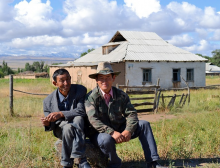 |
Farm in Kyrgyzstan, a country with a high prevalence of undernourishment |
According to a report released by the UN Food and Agriculture Organization (FAO) on December 11th, almost 14.3 million adults, and some 4.7 million children in Europe and Central Asia suffered from severe food insecurity in the three-year period from 2015 to 2017. “While the prevalence of severe food insecurity in Europe and Central Asia at around 2 percent is far lower than the world average of 9.2 percent, it is still cause for concern especially in those countries with persisting hunger and malnutrition,” said FAO senior policy officer Ariella Glinni, the main author of the report.
Central Asia is the subregion with the highest prevalence of undernourishment at 6.2% in 2017, up from 5.8% in 2015. Undernourishment remains an issue of concern especially in Georgia (7.4%), Uzbekistan (7.4%), Kyrgyzstan (6.5%), Serbia (5.6%), Turkmenistan (5.5%) and Albania (5.5%).
According to report, there are subregional differences, with a higher share of women in the Caucasus or Central Asia being affected by severe food insecurity than men. “This signals more fundamental gender inequalities in societies, reflected in access to food as well as food utilization,” Glinni said.
“To ensure that all people, regardless of gender, have adequate food and nutrition, we need to promote coherent measures that can be taken at all levels and in different policy areas.” She added that there is also a need to better understand the situation of different population groups and to address the underlying issues such as poverty, economic and social inequalities, conflicts and other factors. Significant differences in nutrition levels were also observed between urban and rural areas.
“In some countries in Central Asia, stunting among the poorest groups in rural areas was nearly twice as high as in cities,” said the report. “This underlines the importance of addressing the underlying conditions in poor rural areas of poverty, long-term insufficient nutrient intake, poor diets, and frequent infections.”
The authors point out that malnutrition in one or more of its three main forms – undernutrition, overweight and obesity, and micronutrient deficiencies – is present to varying degrees in all countries of the region. Often all three forms coexist, creating what is called the “triple burden of malnutrition.” The growing levels of overweight and obesity in the region are cause for serious concern. Across the Europe Central Asia region, 24.6% of the total population were obese during the period from 2000 to 2016 period, a figure representing 200 million obese people. In Turkey, 32.3% of the population were obese in 2016, followed by Belarus (26.6%), the Ukraine (26.1%) and the Russian Federation (25.7%). The report blames a transition in diets with increased intake of fat, sugar, meat, dairy, and processed foods, often accompanied by a more sedentary lifestyle.
Source- https://www.globalagriculture.org/whats-new/news/en/33514.html









No comments:
Post a Comment